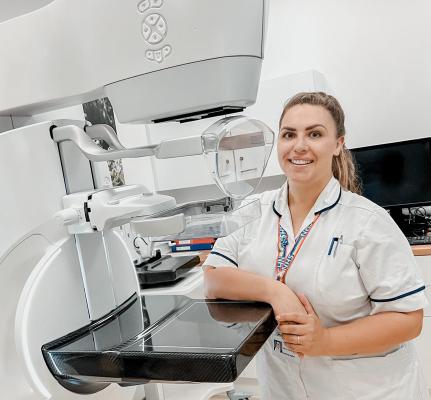Mammographer
Mammographers are registered radiographers who undertake specialist postgraduate training to work within a breast imaging team.
There's evidence that early cancer detection improves chances of surviving breast cancer. As a mammographer, you’ll be an important part of this detection by producing, high-quality mammograms to identify signs of cancer. This may result in people being referred for further diagnosis and treatment.
Life as a mammographer
You'll be part of a multidisciplinary breast imaging team and be responsible for the monitoring and quality assurance tests for specialist X-ray equipment to ensure that it's used safely within set parameters.
You will ensure accurate positioning of the breast to optimise imaging of breast tissue. You will make sure that the breast is in the correct position for the mammogram and use your excellent communication skills to make sure individual needs are supported.
You’ll also play a pivotal role in helping people understand breast health awareness.
Alice Mazarot
Mammographer
Read Alice's storyI have a family history of breast cancer so it’s wonderful to be working in a profession that’s been proven to make an impact on breast cancer mortality.

How much can I earn?
If you’re employed by the NHS, you will be on a national pay and conditions system called Agenda for Change (AfC).
There are nine pay bands and as a mammographer, you'll usually be paid at band 6 with opportunities to progress with experience. Terms and conditions can vary if you are employed outside the NHS.
How about the benefits
As a mammographer, you’ll:
- make a real difference to people's lives, while pursuing a worthwhile, rewarding and varied career
- real opportunities for career development to advanced practice
- work with exciting new technology
- work flexibly with opportunities for part-time hours
- have access to an excellent pension scheme within the NHS
- enjoy NHS discounts in shops, restaurants and online
Must-have skills
- being able to put people at ease during an intimate examination
- adapt to suit the individual needs of the client
- good understanding of breast anatomy, physiology, and pathology, including clinical signs and symptoms of breast cancer
- excellent interpersonal skills
- adaptable and flexible
- maintain patient / client confidentiality
- honest, open and trustworthy
- problem solving skills
- comfortable with new technologies
- working to comply with national guidelines and regulations
- excellent observational skills, as well as an ability to interpret data
Entry requirements
You’ll need to be a Health and Care Professions Council (HCPC) registered diagnostic radiographer or therapeutic radiographer to apply for a postgraduate qualification in mammography. You are able to apply immediately after your radiography qualification should you wish or later in your career.
How to become a mammographer
The training programme is typically a one-year postgraduate certificate or diploma at level 7 that combines academic learning with clinical training. You'll apply for your postgraduate training in mammography via an employer who will sponsor your course at their preferred training provider eg the local university. Your employer will also ensure you have access to the clinical practice in mammography needed for the course.
Where a career as a mammographer can take you
There are a range of career options for mammographers. There may be opportunities to specialise and work towards advanced and consultant practice.
You could also use the skills you have learnt in management, education or research.
-
Mammographer
Bolton, BL4 0JR
- Salary :
- £38682.00 to £46580.00
- Type :
- Permanent
- Employer :
- Bolton NHS Foundation Trust
-
Mammographer
Swindon, SN3 6BB
- Salary :
- £38682.00 to £46580.00
- Type :
- Permanent
- Employer :
- Great Western Hospitals NHS Foundation Trust
-
Mammographer
Dorchester, DT1 2JY
- Salary :
- £38682.00 to £46580.00
- Type :
- Fixed-Term
- Employer :
- Dorset County Hospital NHS Foundation Trust
-
Bank Specialist Radiographer - Mammography
Leeds, LS8 1NT
- Salary :
- Negotiable
- Type :
- Bank
- Employer :
- Spire Healthcare Ltd
-
Senior Mammographer
Exeter, EX2 8ED
- Salary :
- £36000.00 to £41000.00
- Type :
- Permanent
- Employer :
- InHealth Group
-
Bank Mammographer
Guildford, GU1 1LH
- Salary :
- £22.00 to £25.00
- Type :
- Bank
- Employer :
- InHealth Group
-
Bank Radiographer - Mammographer
Farnham, GU10 5XX
- Salary :
- £21.00 to £26.00
- Type :
- Bank
- Employer :
- Spire Healthcare Ltd
-
Band 6 Mammographer
Reading, RG1 5AN
- Salary :
- £29.89
- Type :
- Bank
- Employer :
- NHS Professionals Limited
-
0553 - Senior Mammographer
Barnsley, S75 2EP
- Salary :
- £38682.00 to £46580.00
- Type :
- Permanent
- Employer :
- Barnsley Hospital NHS Foundation Trust
-
QA Lead Mammographer
Guildford, GU11LH
- Salary :
- £45000.00 to £47500.00
- Type :
- Permanent
- Employer :
- InHealth Group
-
Radiographer/Trainee Mammographer
Ashington, NE63 9JJ
- Salary :
- £31049.00 to £46580.00
- Type :
- Permanent
- Employer :
- Northumbria Healthcare NHS Foundation Trust
-
Senior Radiographer/Mammographer
Liverpool, L7 8YE
- Salary :
- £38682.00 to £46580.00
- Type :
- Permanent
- Employer :
- Liverpool University Hospitals NHS Foundation Trust
-
Mammographer/Radiographer (Bank)
Chester, CH4 7QP
- Salary :
- £20.00 to £26.00
- Type :
- Bank
- Employer :
- Nuffield Health
-
Radiographer with special interest in Mammography
Epping, CM16 6TN
- Salary :
- £38682.00 to £46580.00
- Type :
- Permanent
- Employer :
- The Princess Alexandra Hospital NHS Trust
-
Clinical Scientist - Radiation Physics (DR and Mammography)
Maidstone, ME16 9QQ
- Salary :
- £47810.00 to £54710.00
- Type :
- Permanent
- Employer :
- Maidstone and Tunbridge Wells NHS Trust
Showing 6 of 15 results




